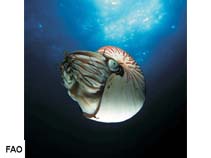Nautilus pompilius Linnaeus, 1758
Emperor nautilus| Native range | All suitable habitat | Point map | Year 2050 |

|
| This map was computer-generated and has not yet been reviewed. |
| Nautilus pompilius AquaMaps Data sources: GBIF OBIS |
Classification / Names Common names | Synonyms | CoL | ITIS | WoRMS
Cephalopoda | Nautilida | Nautilidae
Environment: milieu / climate zone / depth range / distribution range Ecology
Reef-associated; depth range 0 - 750 m (Ref. 275), usually 60 - 240 m (Ref. 1695). Tropical; 20°N - 24°S, 92°E - 180°E (Ref. 1695)
Distribution Countries | FAO areas | Ecosystems | Occurrences | Introductions
Indo-Pacific: from Andaman Islands to Philippines, Australia and Fiji.
Length at first maturity / Size / Weight / Age
Maturity: Lm ? range ? - ? cm Max length : 22.2 cm SHD male/unsexed; (Ref. 1695); max. published weight: 1.7 kg (Ref. 1695)
Short description Morphology
Life cycle and mating behavior Maturity | Reproduction | Spawning | Eggs | Fecundity | Larvae
Main reference
References | Coordinator | Collaborators
Jereb, P. and C.F.E. Roper (eds.) 2005 Cephalopods of the world. An Annotated and Illustrated catalogue of Cephalopod species known to date. Vol. 1. Chambered nautiluses and sepioids (Nautilidae, Sepiidae, Sepiolidae, Sepiadariidae, Idiosepiidae and Spirulidae). FAO Spec. Cat. Fish. Purp. 4(1):262p. Rome: FAO. (Ref. 1695)
IUCN Red List Status
(Ref. 130435: Version 2025-1)
CITES status (Ref. 108899)
CMS (Ref. 116361)
Threat to humans
Human uses
Fisheries: commercial
| FishSource |
Tools
More information
Max. ages / sizes
Length-weight rel.
Length-length rel.
Length-frequencies
Mass conversion
Abundance
Internet sources
BHL | BOLD Systems | CISTI | DiscoverLife | FAO(Publication : search) | Fishipedia | GenBank (genome, nucleotide) | GloBI | Gomexsi | Google Books | Google Scholar | Google | PubMed | Tree of Life | Wikipedia (Go, Search) | Zoological Record



